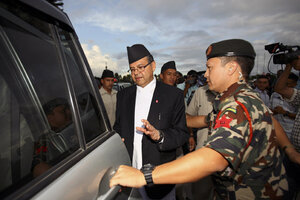Prime minister's short-lived tenure another blow to Nepal
Nepal's president gave the government and opposition parties until Aug. 21 to form a national government after Nepal's prime minister resigned following six months of stalemate.

Nepalese Prime Minister Jhala Nath Khanal (C) leaves after announcing his resignation at the parliament in Kathmandu August 15. Khanal resigned on Sunday pushing the country back into turmoil as political parties scrambled to form a new coalition government and draft a new constitution.
Navesh Chitrakar/Reuters
Katmandu, Nepal
Nepal’s Prime Minister Jhala Nath Khanal, who was elected in February with the support of Maoist former rebels, resigned today after failing to achieve any progress in constitution-writing and settling the future of over 19,000 Maoist former combatants during his six-month tenure.
His resignation comes as the extended term of an assembly to reach consensus on a new constitution after 10 years of civil war is set to expire on Aug. 21 and is likely to throw the country into further turmoil, say analysts.
Political dialogues between the government and the opposition that preceded two extensions of the assembly’s term were messy. And persisting divisions among key political parties offer little hope that it will be any different later this month.
“The political deadlock has lasted so long because the Maoists and the second largest party, Nepali Congress, have been unable to reconcile their differences,” says Krishna Khanal, a political analyst. “The former believes that as the largest party, it has a legitimate claim to lead a coalition, and steward the peace process. But the latter fears allowing the formation of a Maoist-led government would allow Maoist radical agendas to prevail.”
According to Mr. Khanal, the centrist Nepali Congress party must understand the sensitivities of the Maoists who carry the burden of overseeing a tricky transition of thousands of fighters into normal life, partly through rehabilitation and partly through integration with state forces, as agreed in the Comprehensive Peace Agreement signed in late 2006.
Centrists in the country see the delay in disbanding the force as a threat to peaceful politics.
The Nepali Congress is traditionally close to India, and the Maoists are now increasingly close to China, further complicating the issue.
Maoist chairman Prachanda grabbed media headlines in recent weeks for his association with a Chinese NGO, the Asia Pacific Exchange and Cooperation Foundation, which is reportedly planning to invest $3 billion in Nepal’s Lumbini town where Siddhartha Gautam was born.
On Monday, the two parties were already staking claims to lead a new government.
“Once the two parties arrive at a common roadmap, I see the other parties following them. The Maoists’ major ideological conflict is with the Nepali Congress,” Khanal says.
Also on Monday, President Ram Baran Yadav gave the political parties until Aug. 21 to come up with a consensus prime minister. If parties miss the deadline, the president is likely to call for an election.
Given past experience – the outgoing prime minister was elected after 17 attempts by the parliament during seven months – a new government could take a while to form.
“The parties are driven by pursuit of power and are not serious about implementing the peace agreement,” says Yubaraj Ghimire, former editor of The Kathmandu Post.
“The major concern right now is not whether the parties will be able to protect democracy or given a constitution. People are more worried about territorial integrity,” Mr. Ghimire says alluding to threats of secession posed by a promised but so-far unsettled issue of state restructuring.
Many analysts say the efforts to divide the state into administrative units based on ethnic lines as pushed by the Maoists could lead to disintegration of the ethnically diverse country. There are over a 100 castes and ethnic groups in Nepal, according to a national census held in 2001.
